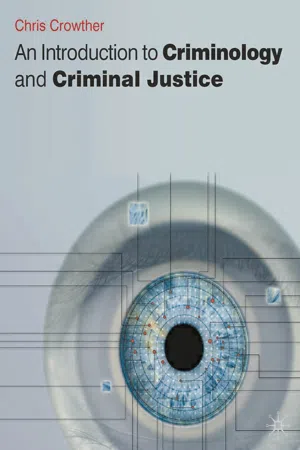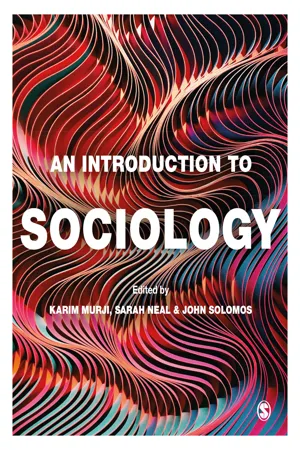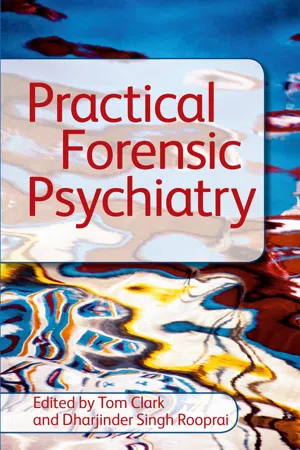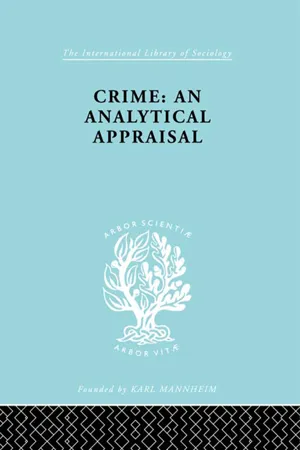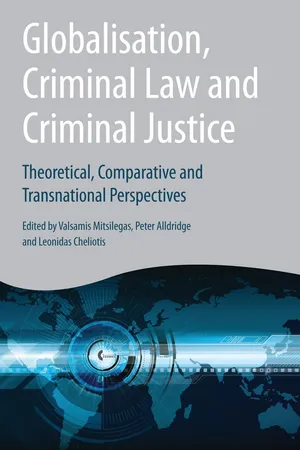Social Sciences
Crime and Society
Crime and society examines the relationship between criminal behavior and the broader social environment. It encompasses the study of crime rates, causes of criminal behavior, and the impact of crime on communities. This field also explores the role of social institutions, such as the legal system and law enforcement, in shaping and responding to criminal activities.
Written by Perlego with AI-assistance
Related key terms
1 of 5
8 Key excerpts on "Crime and Society"
- Chris Crowther-Dowey(Author)
- 2017(Publication Date)
- Red Globe Press(Publisher)
The capacity to comprehend crime from lived experience and mediated versions of social reality is important, but powerful and influential groups in society, including politi-cians and policy makers, also define crime. It is shown that each method of defining crime offers a partial and limited view of the complex processes surrounding the production of definitions of crime. However, taken together they provide a complementary overview. The chapter is split into four main parts. The first provides a rudimentary answer to the question, what is crime? After providing a legalistic definition of crime, the second section shows how crime is understood in common-sense or everyday terms. It looks at five main ways in which crime is seen: on the basis of personal experience, popular press (mass media), political power, practical and professional perspectives, and theoretical perspectives. In the third part, there is a case study tracing the development of legisla-tion related to the police power of stop and search. It examines the various uses of stop and search in relation to a range of different offences, including vagrancy, street crime and terrorism. The fourth section is another case study, the Lambeth cannabis experi-ment, which explores the changing nature of drugs crime and the legislative and policy response to it. WHAT IS CRIME? – A LEGAL DEFINITION This section: ឣ considers the processes involved in defining crime according to a legal perspective ឣ demonstrates that the criminal law changes over time ឣ provides an overview of the official methods and terminology used to classify criminal offences. It is only necessary to turn on the television or glance at a newspaper to see that crime is always in the news (Jewkes, 2004). Society is awash with crime, whether it is represented in factual or fictional terms. Crime is an issue that concerns everybody in one way or another, and this is a situation that is unlikely to change.- eBook - ePub
- Karim Murji, Sarah Neal, John Solomos, Karim Murji, Sarah Neal, John Solomos(Authors)
- 2021(Publication Date)
- SAGE Publications Ltd(Publisher)
4 What is Sociological about Crime? Eamonn CarrabineLearning Objectives
- To understand the key sociological perspectives on crime and how they have developed over time.
- To enable critical reflection on the differences between them and grasp some of the ongoing controversies in the field.
- To become aware of the leading figures and schools of thought in this area of sociology in order to be a confident and critical student of their ideas.
- To locate analyses of crime in broader sociological debates.
- To be able to scrutinize broader criminological ‘texts’ (such as film, TV, press, internet) and make sense of them through the theories discussed.
Framing Questions- In what ways, if any, is crime normal?
- Is deviance still a useful concept?
- What are the relationships between crime and place?
- How do classical ideas impact on more contemporary approaches?
- Why do men commit more crime than women?
IntroductionThe question of crime is one that has the capacity to stretch the sociological imagination endlessly. Crime is a widely used word, a central theme in popular culture and a crucial dynamic shaping the political landscape. Yet, for all the seeming simplicity, there lies considerable complexity and controversy at the heart of the concept of crime. The term ‘crime’ appears in public debate and popular culture as if it is straightforward and obvious what it means, but the concept has many meanings and is rooted in certain social processes that have powerful ramifications.Mapping the TerrainCrime is always socially defined. Inevitably, this proposition provokes debate, and several competing approaches have been identified, ranging from a ‘legal-consensus’ definition through to one that is best understood as both ‘critical’ and ‘utopian’ (Greer and Hagan, 2001: 208–13). The differences can be summarized as follows:- The legal consensus
- eBook - PDF
- Tom Clark, Dharjinder Singh Rooprai(Authors)
- 2011(Publication Date)
- CRC Press(Publisher)
170 14 Crime and Criminology Criminology is the observational study of crime: • A crime may be defined either by statute (an increasing proportion of offences) or by common law (e.g. murder, perverting the course of justice): – Many other jurisdictions have an exhaustive criminal code defining all offences in statute. • An action is described as a crime according to socio-cultural norms and expectations, which vary with time: – Previously tolerated behaviours may become unacceptable (e.g. domestic violence, smoking). – Previously proscribed behaviours become accepted (homosexuality, swearing and suicide). – New criminal activity develops (Internet crime). – Different societies have different norms (e.g. age of consent for sexual intercourse). • There are two criminological aspects: – Criminal behaviour, including who does what and why, patterns and trends of crime, victims and causes of crime. – Society’s response to crime, encompassing societal expectations and morality and the criminal justice system. Criminological theory has developed over several hundred years and continues to develop: • There are many theories of crime; no single theory is adequate to explain all crime or all offenders. • Theories often overlap and are sometimes contradictory. • Academic thinking has been variously influenced by sociology, psychology, law, social anthropology, economics and psychiatry. • Some theories are more influenced by psychology and psychiatry than others (e.g biological and psychological positivism). ● Criminological Theories Some of the major theories are considered here. See Maguire et al . (2007) or Newburn (2007) for a more complete and detailed account. Classicism (1700s to early 1800s) Key figures: • Cesare Bonesana, Marchese of Boccaria (known as Boccaria); Jeremy Bentham. Each individual acts according to choice, as a ‘rational actor’, and weighs up the benefits and consequences of their actions. So they choose to commit crime: - eBook - ePub
Crime
An Analytical Appraisal
- Manuel Lopez-Rey(Author)
- 2013(Publication Date)
- Routledge(Publisher)
2 Crime as a social problem
It has been shown that together unknown and known but unreported crime are more extensive and serious than reported crime. Therefore criminal statistics are not the only source of knowledge about crime; officials, authorities and highly placed persons, although unpunished, are frequently offenders; and, in the main, those responsible for reported crime are a socially, economically and psychologically well-defined group.The extent of crime and the variety of social groups involved refute the thesis that it can be explained by causal generalizations, or that as a problem it can be dealt with as part of socio-economic planning. In order to be understood, it must be viewed in the light of such an ensemble as socio-economic change, the structure of the general population, political organization and stability, and politico-social values.The persistence and widespread increase of crime, in spite of all efforts to reduce it, raise a series of questions about the necessity for a new approach to the prevention of crime and the treatment of offenders; the effectiveness of criminal justice and the need to review the system of values it protects; as well as the validity of the distinction between crime and delinquency.All these questions show clearly the socio-political character of crime, both as a general and as an individual event; it is essentially a policy problem and should be dealt with as such. Scientific findings should be used within the limits imposed by political and policy considerations, among which respect for human rights is of primary importance. Owing to its complexity, crime defies scientific integration if this is understood as putting together all the parts in order to form a scientific whole.This puts crime in a different perspective which has not, up to now, been contemplated. Only recently has it been fully realized that the unknown territory of crime requires attention from a political and scientific point of view. It means that the criminal justice system should be organized so as to reduce the non-reported areas of crime, and that some of the pillars of contemporary research have to be abandoned and new ones built up. - eBook - PDF
Crime and Law
Theory, Research, and Policy
- Anne Wade(Author)
- 2019(Publication Date)
- Society Publishing(Publisher)
CRIME AND CRIMINOLOGY CHAPTER 1 CONTENTS Abstract ..................................................................................................... 2 1.1. Introduction ........................................................................................ 2 1.2.What is Criminology? .......................................................................... 3 1.3. An Overview of Criminal Law ............................................................. 7 1.4. Crime Theories .................................................................................. 11 1.5. Organizing Theories of Crime ........................................................... 16 1.6. Origins of Crime Theory .................................................................... 17 1.7. Crime Policies ................................................................................... 20 1.8. Limitations of Criminology Research ................................................. 24 Crime and Law: Theory, Research, and Policy 2 ABSTRACT This chapter aims to make sure that the reader understands the definition of criminology and how it relates to other social sciences. Readers should be able to grasp the scientific theory concept and how it relates to crime policy and research. We will also highlight the overview of crime theory and how it is related to some of the causes of crime. The reader should also be able to understand the politics behind criminology and its place in the social context. This chapter aims to introduce the basic understanding of the topics that will be covered in all the nine chapters of the book. 1.1. INTRODUCTION Crime is a societal development that tends to capture the public’s attention. The public is ever ready to demand some action from the relevant authorities whenever crime statistics soar or a criminal activity captures the public interest. - eBook - PDF
Sociology
The Essentials
- Margaret L. Andersen; Howard F. Taylor, Margaret Andersen, Howard Taylor(Authors)
- 2016(Publication Date)
- Cengage Learning EMEA(Publisher)
Groups such as Alcoholics Anony-mous, Weight Watchers, and various twelve-step pro-grams help those identified as deviant overcome their deviant behavior. These groups, which can be quite effective, accomplish their mission by encouraging members to accept their deviant identity as the first step to recovery. Crime and Criminal Justice The concept of deviance in sociology is a broad one, encompassing many forms of behavior—legal and illegal, ordinary and unusual. Crime is one form of deviance, specifically, behavior that violates particu-lar criminal laws. Not all deviance is crime. Deviance becomes crime when institutions of society designate it as violating a law or laws. Criminology is the study of crime from a scien-tific perspective. Criminologists include social sci-entists such as sociologists who stress the societal causes and treatment of crime. All the theoretical perspectives on deviance that we examined ear-lier contribute to our understanding of crime (see ◆ Table 7.2). According to the functionalist perspec-tive, crime may be necessary to hold society together. By singling out criminals as socially deviant, others are defined as good. The nightly reporting of crime on television is a demonstration of this sociological function of crime. Conflict theory suggests that disad-vantaged groups are more likely to become criminal. Conflict theory also sees the well-to-do as better able to hide their crimes and less likely to be punished. Symbolic interaction helps us understand how peo-ple learn to become criminals or come to be accused of criminality, even when they may be innocent. Each perspective traces criminal behavior to social condi-tions rather than only to the intrinsic tendencies or personalities of individuals. ◆ Table 7.2 Sociological Theories of Crime Functionalist Theory Symbolic Interaction Theory Conflict Theory Societies require a certain level of crime in order to clarify norms. Crime is behavior that is learned through social interaction. - eBook - PDF
Globalisation, Criminal Law and Criminal Justice
Theoretical, Comparative and Transnational Perspectives
- Valsamis Mitsilegas, Peter Alldridge, Leonidas Cheliotis, Valsamis Mitsilegas, Peter Alldridge, Leonidas Cheliotis(Authors)
- 2015(Publication Date)
- Hart Publishing(Publisher)
Three such broad approaches in criminological and penologi-cal literature seem most prominent. The first is a social harm conception of crime, richly elaborated in various ways. On this view the essence of crime (or perhaps the fundamental problem that legal ideas of crime only partly address) is serious 33 See, eg M Renzo, ‘Crimes against Humanity and the Limits of International Criminal Law’ (2012) 31 Law and Philosophy 443, 454, claiming that accountability for crimes against humanity is ‘to the members of the international community (rather than just to their fellow citizens)’. 34 On the idea of networks of community as the locus of law and as sources of legal authority, see R Cotterrell, Living Law: Studies in Legal and Social Theory (Aldershot, Ashgate, 2008) 17–28; and gen-erally, R Cotterrell, Law, Culture and Society: Legal Ideas in the Mirror of Social Theory (Aldershot, Ashgate, 2006). 35 R Cotterrell, ‘What is Transnational Law?’ (2012) 37 Law & Social Inquiry 500. 18 Roger Cotterrell social harm or injury, 36 or the creation of danger, significant risk or insecurity to individuals or society. The second approach views crime as upsetting a ‘moral bal-ance’ in society, so that justice requires punishment of the offender to re-establish this – to proclaim society’s condemnation, its recognition and its judgement of the gravity of the wrong done; in this perspective, law in practice might not always provide what criminal justice is thought to require. 37 The third approach is grounded in a need to protect human rights and dignity so that what the idea of crime recognises (or should recognise) are serious denials or attacks on basic con-ditions of life that humans are entitled to enjoy. 38 In the context of discussion here, these approaches suggest possible broaden-ings of or amendments to politico-legal ideas of crime – ones that might reflect sentiments, interests, values or traditions not always seen as fully reflected in criminal law. - eBook - PDF
- Francis T. Cullen, Pamela Wilcox, Francis T. Cullen, Pamela K. Wilcox(Authors)
- 2009(Publication Date)
- SAGE Publications, Inc(Publisher)
And there is the matter of levels of analysis. Explaining why some but not other individuals engage in criminal conduct is not the same as explaining why some but not other areas—whether neighborhoods or nations—have higher or lower crime rates. The complexity of the solutions proposed for the crime-causation puzzle is complicated still fur-ther by two considerations. First, similar to other social science disciplines, criminology has divided itself into “schools of thought.” But theorizing about crime is dynamic, not static. Thus, within these schools, classic works defining the theoreti-cal tradition initially appear and establish a new way of thinking about crime. This is not the end of the story, however. After a period of time, subse-quent writings are forthcoming that elaborate dif-ferent features of the classic statement. These latter contributions may be diverse and then may them-selves be elucidated—adding even more theoretical complexity. An understanding of theoretical crimi-nology thus involves tracing the development of schools of thought, in all their twists and turns, from past to present. Second, how we think about crime is shaped not only by science or “what the data say” but also by our social experiences. Depending on the era in which we live and what we have experienced dur-ing that era, different ideas will or will not reso-nate with us—that is, they will strike us sensible or as “obviously wrong.” This insight—that social circumstances influence the production and accep-tance of scholarly ideas—is the central thesis of the sociology of science. At any given time, therefore, the theories that are created and embraced may be due not only to the inherent logic of science but also to the social and political beliefs that scholars import into their work. Theoretical complexity is thus an inevitable feature of criminology, which is a very human enterprise in the sense that we are endeavoring to unlock the mysteries of our own behavior.
Index pages curate the most relevant extracts from our library of academic textbooks. They’ve been created using an in-house natural language model (NLM), each adding context and meaning to key research topics.
